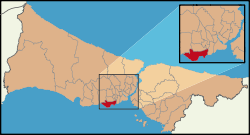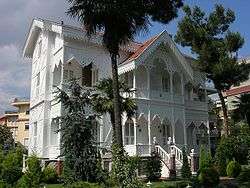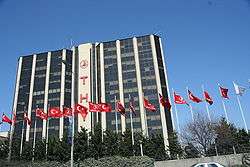Bakırköy
Bakırköy is a neighbourhood, municipality and district on the European side of Istanbul, Turkey. The quarter is densely populated, has a residential character and is inhabited by an upper middle class population. The municipality of Bakırköy is much larger than the quarter and also includes several other neighbourhoods, such as Yeşilköy, Yeşilyurt, Ataköy. Bakırköy lies between the ![]()
Bakırköy | |
|---|---|
.jpg) | |
 | |
 Bakırköy | |
| Coordinates: 40°58′59″N 28°51′13″E | |
| Country | Turkey |
| Province | Istanbul |
| Government | |
| • Mayor | Bülent Kerimoğlu (CHP) |
| • Kaymakam | Dursun Ali Şahin |
| Area | |
| • District | 32.42 km2 (12.52 sq mi) |
| Population (2012)[2] | |
| • District | 221,336 |
| • District density | 6,800/km2 (18,000/sq mi) |
| Website | www.bakirkoy.bel.tr |
History
During the Byzantine times Bakırköy was a separate community outside Constantinople, a well-watered pleasant seaside retreat from the city, and was called Hebdomon (Greek: Ἕβδομον, "the Seventh", i.e. seven Roman miles from the Milion, the mile-marker monument of Constantinople).[3] Here - where nowadays the Ataköy Marina lies - the Emperor Valens built one of the two Imperial Palaces bearing the name of Magnaura, while Justinian erected another Palace named Jucundianae, also placed near the seaside.[4] Two churches, dedicated respectively to St. John the Evangelist and to St. John Baptist the Forerunner, the latter hosting the head of the Saint and burial place of the Emperor Basil II, were also erected here.
Hebdomon was a place of exercise and concentration of the Thracian army. It had a large Field of Mars, the Kampos tou Tribounaliou (Greek: Κάμπος τοῦ τριβουναλίου) in Latin Campus Tribunalis, where several Emperors were elected through acclamation by the army.[5] Among them were Valens, Arcadius, Honorius, Theodosius II, Phocas, Nikephoros II Phokas.[5] The Campus lay in the valley of Veli Efendi, where now the horse race course is placed.[6] The imperial court came often to the Hebdomon to attend military parades, to welcome the emperor coming back from campaign, and to pray in the large church of St. John Baptist the Forerunner.[5]
Later the place was also named Makrohori (Greek: Μακροχώρι "long village"), which was adapted to Makriköy (Turkish: Köy "village") in the Ottoman period, when many large houses were built here. In 1925 the ancient denomination was changed to Bakırköy ("Copper village") by imposition of a law which suppressed all place names of non-Turkish origin.[7] It was a district in Beyoğlu province between 1923 and 1926 and the district was also included present ones of Avcılar, Bağcılar, Bahçelievler, Başakşehir, Esenler, Güngören, Küçükçekmece, western boroughs of Zeytinburnu and small part of Arnavutköy before 1957. It was the biggest district of Turkey before separation of Küçükçekmece one (Avcılar was included in and became the district in 1992) in 1987 and ones of Bağcılar, Bahçelievler and Güngören in 1992. Later Esenler district was formed from some boroughs from Bağcılar and Güngören in 1994 and Başakşehir one formed from some boroughs from Büyükçekmece (Bahçeşehir area), Esenler and Küçükçekmece in 2009. Also small area around villages of Şamlar part of newly founded Arnavutköy district.
Makriköy was renamed "Bakırköy" in 1925, during the change of foreign originated names within national borders. Yesilkoy (San Stefano), located within the boundaries of the district, was occupied by the Russian in 1877-1878, the Treaty of San Stefano was also signed here on 3 March 1878.

There is little remaining of historical significance in the area: what there is includes a cistern (Fildamı Sarnıcı),[8] a powder house from the 17th century (today used as Yunus Emre Kültür Merkezi in Ataköy), the Greek Orthodox church of Saint George (consecrated on May 2, 1832) and a Greek school, the central mosque and fountain of 1875, an Armenian Church and school and the resting place of the Muslim saint Zuhurat Baba, a Turkish soldier who died during the conquest of Constantinople. His resting place is often visited by women on Fridays. The seafront is now a popular location for tea gardens, clubs and restaurants, (although the beaches have been unusable for decades).
After 1960, the population increased rapidly. As a result of this rapid growth; In the 1950s, rural settlements such as Güngören, Kocasinan and Sefaköy quickly turned into slums with title deeds. A similar development took place in Esenler, Yenibosna and Yeşilbağ around Halkalı in the 1970s. However, Küçükçekmece was the first settlement within the borders of Bakırköy district that showed rapid development and became a separate municipality in 1956.
Bakırköy became a popular residential area in the late 19th century after the construction of a railroad connection to İstanbul and until the 1970s was one of the most relaxed and desirable locations in the city. It is still populated by Istanbul's upper middle-class (tradespeople, bureaucrats, the retired).
Some parts of Bakırköy are very pleasant residential areas, particularly the streets from the hospital downwards to the sea. The planned satellite town of Ataköy to the west of Bakırköy centre is very tidy indeed, and was one of Turkey's first planned residential developments. Ataköy contains much social infrastructure including the Galleria shopping center and yacht marina.
Today
The centre of Bakırköy is an important commercial district. There is a huge shopping district (including a number of huge shiny shopping centres as Carousel), a range of cinemas, bars and cafés, as well as conversion of streets to pedestrian malls.
Bakırköy is easy to reach by public transport; there are dolmusues to Beyoğlu throughout the night; there are buses to Mecidiyeköy (although using the ![]()
Built in 1913, Veliefendi Race Course, Turkey's largest and oldest modern horse-racing track (not including the ancient hippodromes in Turkey), is in close proximity.
Istanbul's largest mental hospital is in Bakırköy, and the parkland surrounding it is the largest green space in the district.
There is a popular belief that the underground water of Bakırköy comes from the river Danube.
Being near the Fault in the Sea of Marmara, Bakırköy is vulnerable to earthquake damage.
Economy

The headquarters of Turkish Airlines are on the grounds of Istanbul Atatürk Airport in Yeşilköy in Bakırköy.[9] Borajet also has its head office in Yeşilköy.[10]
Places of interest
- Istanbul Atatürk Airport, Yeşilköy
- World Trade Center Istanbul, Yeşilköy
- Bakirkoy Synagogue, Bakırköy
- Carousel Shopping Center, Bakırköy
- Galleria Ataköy, Ataköy
- Beyti Restaurant, Florya
- Sport venues
- Ataköy Athletics Arena, Ataköy
- Sinan Erdem Dome, Ataköy
- Florya Metin Oktay Sports Complex and Training Center, Florya
- Şenlikköy Stadium, Florya
- Culture
- Bakırköy Synagogue
- Fildamı Sarnıcı, Bakırköy
- Florya Atatürk Marine Mansion, Florya
- Istanbul Aviation Museum, Yeşilköy
- Yeşilköy Lighthouse, Yeşilköy
Sport
The neighbourhood association football team is called Bakırköyspor, once one of top teams in the country, currently a local lower league outfit.
Notes, References
- "Area of regions (including lakes), km²". Regional Statistics Database. Turkish Statistical Institute. 2002. Retrieved 2013-03-05.
- "Population of province/district centers and towns/villages by districts - 2012". Address Based Population Registration System (ABPRS) Database. Turkish Statistical Institute. Retrieved 2013-02-27.
- Janin (1964), p. 446
- In this palace, also named Secundianae, the Emperor used to meet his jurists during the compilation of the Corpus Juris Civilis. Janin (1964), p. 140
- Janin (1964), p. 447
- Janin (1964), p. 448
- Tuna (2004)
- With dimensions of 127 m x 76 m and a depth of 11 m, this large open sky cistern was used to provide water for the imperial palaces of the Hebdomon. Its Turkish name ("Cistern of elephant's stable"), derives from its usage in the Ottoman Empire as a stable for the Sultan's elephants. Janin (1964), p. 205
- "Contact Us." Turkish Airlines. Retrieved on 24 June 2009.
- "Contact Us." Borajet. Retrieved on 16 February 2011. "ADDRESS İDTM Blokları A-3 Blok Kat:5 Yeşilköy 34149 / İstanbul-TURKEY"
Sources
- Janin, Raymond (1964). Constantinople Byzantine (in French) (2 ed.). Paris: Institut Français d'Etudes Byzantines.
- Tuna, Turgay (2004). Ayastefanos'tan Yeşilköy'e (in Turkish).
External links
| Wikimedia Commons has media related to Bakırköy. |
